All of us know that all 7 wonders of the world were a collection of remarkable constructions listed by various Greek authors. Now scientists think that they have rediscovered an eighth wonder of the world.
Once known as the natural eighth wonder of the world, the largest silica deposits of their kind on Earth were destroyed by the 1886 eruption of Mount Tarawera. But now, researchers at New Zealand, located where they were destroyed. They even assumed some of them have been preserved this whole time.
Rex Bunn, one of the team said, “They became the greatest tourist attraction in the Southern Hemisphere and the British empire, and shiploads of tourists made the dangerous visit down from the UK, Europe, and America to see them.”
“But they were never surveyed by the government of the time, so there was no record of their latitude or longitude.”
The the planet. The white terrace was sat on the north-east end of Lake Rotomahana in northern New Zealand and the pink terrace’, sat on another shore nearby. In addition, the pink hue found in some of the terraces because of the presence of extensive colonies of a pigmented bacteria.
Bunn, in 2016 found an old field diary that belonged to 19th-century geologist Ferdinand von Hochstetter. von Hochstetter had recorded raw data from a compass survey of Lake Rotomahana, located 20 kilometers (12 miles) to the southeast of the city of Rotorua in northern New Zealand. Almost before 3 decades, the volcanic eruption, the pink and white terraces were plainly marked in the area.
After that, Bunn along with Nolden started reconstructing von Hochstetter’s lake map using a technique called forensic cartography.
Bunn said, “We would have put in 2,500 hours of research in the last 12 months. We’re confident, to the best of our ability, we have identified the terrace locations. We’re closer than anyone has ever been in the last 130 years.”
After researching over it, Bunn has developed an algorithm that pinpoints the location of the pink and white terraces with a margin of error of plus or minus 35 meters.
He said, “When you’re talking about a landmark that spans hundreds of meters, that’s a close enough estimate to make digging them out a reality.”
Now he is expecting that if they do decide to dig the terraces out, they will find some part of them still intact.
